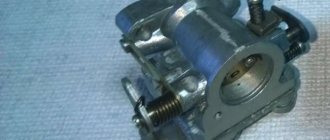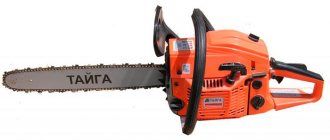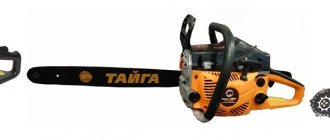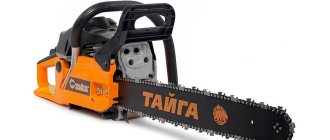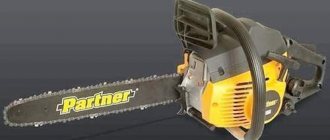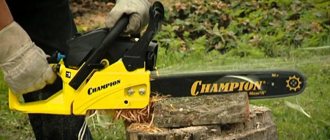Chainsaw Taiga 214
The Taiga 214 chainsaw,
which has been tested for years of operation , is still in demand because... has high maintainability and a large number of components on the domestic market of household and construction tools. It is used not only for cutting/felling trees, but also for bucking wood, which allows it to be used for construction, procurement and auxiliary work.
Taiga 214 chainsaw device
The design features make it possible to cut any wood, including wet and freshly cut wood.
The saw model is equipped with a single-cylinder engine with a gearless drive. It is equipped with a muffler and auxiliary systems for power supply, cooling and lubrication of the sawing apparatus. For comfortable use, it has a balancing mechanism.
The cooling system is implemented using a fan and is of the air type. The saw chain is lubricated automatically under pressure without operator intervention.
Saw Taiga 214 without tire
Chainsaw Taiga 3650 – advantages of the model
Among the distinctive features of this semi-professional chainsaw are reduced weight, improved ergonomics, and durable factory components. The balanced design and low center of gravity of this tool allow it to be actively used directly on trees, dilapidated roofs of buildings and other hard-to-reach places.
In the original proprietary equipment, this Taiga brand chainsaw is equipped with a reliable 2-stroke power unit, equipped with an all-metal crankshaft, a chrome-plated working cylinder and a piston with two standard rings. To reduce vibrations of the running motor, 6 rubber-metal springs are located underneath it. The seventh damper is located under the handle for the operator - this factory arrangement more effectively dampens engine vibrations, making the operation of the saw more convenient and efficient.
Read also: How to use a miter box for ceiling plinths
Technical characteristics of the Taiga 3650 petrol tool include:
- engine power – 4.9 l. With.;
- fuel/oil tank – 550/260 ml;
- bar length/chain pitch – 45 cm/0.325″;
- weight with headset and filled tanks – 6.65 kg.
This popular model is pre-equipped with a proprietary bar and cutting chain, the lubrication of which is controlled by an oil pump. Its performance can be adjusted depending on specific tasks. The chain is tensioned using a separately installed side screw.
Technical characteristics of the Taiga 214 chainsaw
The weight of the device excluding fuel and lubricants is 8.8 kg. At the same time, the fuel tank capacity is designed for 0.8 liters, and the volume of the lubricant reservoir is 0.3 liters. Overall dimensions of the chainsaw – 857x280x272 mm. The sawing apparatus consists of a 38 cm bar with a driven sprocket, and is complemented by a chain with a pitch of 9.3 mm.
Productivity is about 65 cm3/s, provided that workpieces with a diameter of up to 30 cm are cut. At the same time, fuel consumption is 440 g/hp/h. This is ensured by the use of a 3.5-horsepower engine. A gasoline-oil mixture in a ratio of 20:1 is used as fuel. For these purposes, gasoline grades A-72 or 76 and oil M-8A or AC-9.5 are used.
Noise pollution is within the norms and is limited to 106 dB.
Technical characteristics of Taiga 52cc
The semi-professional chainsaw Taiga 52cc has significant advantages over the first two models. Its power is slightly greater (2.8 kW, 3.7 hp), but the weight is significantly less. It is 5.5 kg. That is, such equipment will be much easier to manage. The fuel tank holds 0.55 liters. The tire, however, has a length of 52 cm.
From the information received, we can conclude that the Taiga chainsaw is a good option both for home and work.
Reviews of the Taiga 214 chainsaw
David The old saw was inherited from his parents. They bought it a long time ago. Starting it is difficult, almost impossible. Therefore, if it starts, it is better not to turn it off until the gas runs out.
Vladimir I literally have spare parts left from the saw. In an attempt to fix it, I dismantled it to the ground. As a result, it has been lying around in the garage for three years.
Tigran Compared to modern saws, this model is unreasonably heavy. It can only be used if there are no quality alternatives.
Taiga 214 chainsaw
Due to the wide range of work performed, performance and repairs, this model continues to be widely used among users. The device is quite massive and reliable; the saw mechanism is capable of processing any type of wood, wet wood. The engine is single-cylinder, air-cooled. The saw unit is automatically lubricated.
Compared to more modern models, this saw is too bulky and heavy, and breakdowns can occur in various tool systems. But these shortcomings are justified by its power and high degree of integration of parts.
Characteristics:
- Capacity. 3.5 l. From.;
- Chain pitch. 9.3 mm;
- Fuel tank volume. 800 ml;
- Oil tank. 300 ml;
- Fuel consumption. 40 GW/hour;
- Tire length. 38 cm;
- Noise level. 106 dB;
- Weight. 8.8 kg;
- Dimensions. 857280272.
Specifications
First of all, it is worth considering the characteristics of the engine and fuel system. No one will be surprised that the Taiga 214 runs on a two-stroke engine whose volume is 75 cm3. The cylinder is characterized by a unique location - perpendicular to the guide bar. The crankshaft speed is modest, 7,000 rpm. This is quite enough to cope well with various tasks.
The tool is small but very powerful. If you run the tool at maximum rotation, you can squeeze 3.5 horsepower out of the Taiga 214, which makes it possible to use a tire up to 38 cm in length.
It is important to take care of your engine and tool by choosing the best fuel for it. Like all two-stroke chainsaw engines, the 214 Taiga engine requires an ideal mixture, which consists of high-quality gasoline and synthetic oil. In this case, it is important to take into account the value of 600 g/kW, h, which is responsible for the consumption of the oil-fuel mixture. It is worth studying the instructions first to ensure that you mix the mixture accurately and adhere to the recommended ratio. In terms of the structure of the fuel system, manufacturers are not surprised. This comes standard with a filter, carburetor and high-quality fuel line.
When considering the features of the Taiga 214 chainsaw, one should not lose sight of the carburetor, which is equipped with a fuel pump whose diaphragm operates due to air pulses. Adjusting the carburetor is easy because it has several screws that help you make fine adjustments. A pair of screws are responsible for minimum and high speed, and the third is for idle speed.
In Taiga 214 you can see an interesting addition in the form of an air damper. It is equipped with a control lever that allows the operator to quickly adjust the cold air flow.
A description of the features of the Taiga 214 would not be complete without characteristics of the guide bar and chain. The tire has a shock-absorbing insert, which is distinguished by a driven sprocket. Thanks to metal springs and groove-shaped connections, it is attached to the main rail. Thanks to the structure, working with the tool becomes simple. The chain pitch does not exceed 9.3 mm.
The manufacturers decided to install the tire on the opposite side to the starter. It is located next to the brake system cover, which has fasteners consisting of a pair of nuts. Here you can also find a screw that is responsible for adjusting the chain tension.
The ignition system also has features. Thanks to the non-contact magnetic system, the ideal operation of the system even at maximum speed, the chainsaw starts smoothly and quickly. Sparking is ideal thanks to the diode bridge and generator coil.
The plunger pump supplies oil through the line. The pump is attached to the main sprocket. Overall, the oil supply is automatic and efficient. This reduces chain wear and allows you to work efficiently with the tool. The best lubricating oils are those that have excellent adhesive characteristics.
For lovers of domestic chainsaws of decent quality and good characteristics, we offer our article - Review of the Lesnik 3816 chainsaw.
The starting mechanism in this chainsaw model is located next to the flywheels; the starter is manual.
Technical characteristics and description of the chainsaw design
Engine and fuel system
The Taiga 214 chainsaw is equipped with a two-stroke internal combustion engine with a volume of 75 cm 3, the cylinder of which is located perpendicular to the chainsaw tire. The maximum crankshaft rotation speed is 7 thousand rpm, which is a rather modest figure compared to imported analogues. The power of the tool at maximum speed is 2.6 kW or 3.5 liters. With. this allows the use of a tire with a working length of 38 cm.
To operate, Taiga 214 uses a mixture of gasoline and oil for two-stroke engines. Fuel consumption is 600 g/kW, h. The proportion of the fuel mixture is twenty parts gasoline to one part oil.
The fuel system consists of a carburetor, fuel line and filter. The fuel filter is installed in the tank. The carburetor in the Taiga chainsaw is a single-chamber, diaphragm carburetor with a built-in fuel pump.
The fuel pump diaphragm is driven by an air pulse from the crankcase. The carburetor has three adjusting screws, one of which is responsible for adjusting the idle speed, the other two for working at low and maximum speeds.
The carburetor also has an air damper with a control lever connected to it, with the help of which the operator can regulate the air supply when starting a cold engine.
Bar and chain
As standard, the Taiga 214 chainsaw tire is equipped with a driven sprocket mounted on a shock-absorbing tab and connected to the main tire by means of a connection in a groove supported by metal springs, which makes its operation quite soft and slightly increases its service life.
It is also permissible to install a solid tire as on imported analogues. The chain has a pitch of 9.3 mm.
The tire is installed on the opposite side of the starter directly onto the crankcase and is pressed by the saw chain brake cover-housing using two nuts. The chain tension adjustment screw is located where the bar is installed.
Ignition system
The Taiga 214 chainsaw is equipped with non-contact magnetic ignition with an advance angle of 30 degrees at the maximum speed of the chainsaw. It consists of a flywheel mounted on the engine crankshaft and a housing mounted on the crankcase. The ignition housing contains a transformer, a generator coil and a diode bridge, which are responsible for the quality of spark formation.
A spark plug of the AM 17 V model is installed on the Taiga 214; the optimal gap on its contacts is 0.6–0.7 mm. A protective cap is installed at the end of the high-voltage wire, and the wire itself is protected by shielding material.
Lubrication system
Chain lubricant is supplied from the oil tank through lines using a plunger pump installed at the base of the drive sprocket. The feed is carried out automatically and increases in proportion to the increase in the engine speed of the chainsaw. It is recommended to use oils with high adhesive characteristics as lubricants.
The oil tank capacity is 0.25–0.3 liters.
Lubrication of engine parts (piston, crankshaft bearings) occurs due to oil diluted in gasoline; it is for this reason that it is unacceptable to use pure gasoline in a two-stroke engine.
In order for the Taiga 214 chainsaw engine to jam, it only needs to run on pure gasoline at high speeds for just a few minutes.
Saw chain clutch and brake
The force from the engine to the driving sprocket of the tool is transmitted through a centrifugal clutch, which consists of a driving part and a driven part. The clutch assembly, using a left-hand thread, is installed on the crankshaft on the opposite side of the flywheel. As the number of revolutions increases, the driving part of the clutch, under the influence of centrifugal force, opens and comes into contact with the driven part, thereby setting it in motion.
Design and principle of operation
Carburetor. This is a device in which fuel (gasoline) and air are mixed in specified proportions and then the finished mixture is fed into the engine cylinder. Almost all models of chainsaws have the same type of carburetors, so the design and operating principle are the same.
The main elements of the carburetor design are:
- Body which is cast in aluminum to reduce weight. Chainsaws are constantly moved from place to place and are held in hands while working, so reducing tool weight is a priority for manufacturers;
- Diffuser with an air damper located at the inlet;
- Jets , presentation of valves for metered fuel supply;
- Spray , ensuring the injection of gasoline into the chamber (in the diagrams it is designated as the main nozzle);
- Fuel (float) chamber.
READ How to count the teeth on a chainsaw chain correctly
Figure 1. Diagram of a carburetor chainsaw
The operating principle of a carburetor can be described as a cycle consisting of the following stages:
- The choke valve opens when the engine starts.
- The stroke of the piston creates a vacuum in the air channel, as a result of which air enters the diffuser, the amount of which is regulated by the position of the air valve.
- From the gas tank, gas enters the float (fuel) chamber. The speed of its entry is controlled by nozzles.
- Gasoline and air are mixed in the diffuser, resulting in the formation of an air-fuel mixture, which then enters the engine cylinder. The more mixture enters the combustion chamber of the cylinder, the higher the power and speed at the engine shaft.
The most common breakdowns of the Taiga 214 and their elimination
As with any equipment, breakdowns sometimes occur in the Taiga chainsaw; we will list the most common ones and consider how to diagnose and fix the malfunction.
Engine won't start
The most likely reason that the engine does not start is the lack of a spark between the spark plug electrodes or an interruption in the fuel supply. In this regard, the following actions must be taken:
- Check the spark and condition of the electrodes on the spark plug and, if necessary, clean or replace it.
- Check the presence of fuel in the tank.
- Inspect the chainsaw for fuel leaks through torn fuel lines, and repair if found.
- Clean the fuel filter
- If the spark plug is wet and there is a spark on it, the most likely cause of the breakdown is a poor-quality fuel mixture. To fix this, you need to adjust the carburetor.
The engine does not develop full power
- It is necessary to check what position the saw chain brake is in; if it is on, turn it off.
- If the Taiga 214 confidently holds idle speed and at the same time does not develop full power, the reason is most likely in the carburetor settings. The high speed screw needs to be adjusted.
- Check the engine crankcase for leaks, if the idle speed fluctuates and eliminate them if detected
The instrument stalls
If the chainsaw stalls, the actions described in the paragraph “Engine will not start” will help.
Chainsaw doesn't cut well
- In this situation, the problem is most likely a dull saw chain of the tool. It needs to be replaced with a new one or sharpened.
- Check the supply of lubricant to the saw bar; if it is missing, diagnose the lubrication system and eliminate malfunctions.
The tire pulls to the side
- It is necessary to inspect the tire and, if increased wear is detected, replace it with a new one.
- The teeth of the chain on one side are much higher than the teeth on the other side; it is necessary to sharpen the chain correctly and adjust the cutting depth.
The driven tire sprocket rotates with jamming
The problem is that debris has gotten into the sprocket bearing, you need to wash the tire in gasoline and check again; if such actions do not help, then the cause is wear of the bearings and the tire needs to be replaced.
The chain spins at idle
The main reasons why the chain may spin at idle are incorrect idle speed adjustment on the carburetor and a broken spring in the clutch mechanism of the tool. You must first inspect the clutch for faults and eliminate them if any, and then, if necessary, adjust the idle speed on the carburetor.
How to adjust the carburetor with your own hands?
After washing and thoroughly cleaning the carburetor, they are assembled and begin to be adjusted. First of all, you need to understand the purpose of the adjustment screws. This will help the instructions, but some general points should be addressed immediately. The most common screw designation is:
- N. _ Regulates the state of the main jet, i.e. Sets the maximum rotation speed of the motor shaft;
- L. _ Regulates idle nozzles (responsible for the minimum shaft rotation speed);
- T. _ Regulates engine idle speed. It can also be marked with the letters LA or S; on some carburetor models it is completely absent.
Turning screws H and L clockwise depletes the air-fuel mixture and enriches it counterclockwise (the amount of gasoline increases). When screw T rotates, the shaft rotation speed changes at idle speed. Clockwise, it increases and decreases in the opposite direction.
Figure 2. Carburetor adjustment mechanisms
Before taking direct action, it is necessary to find and carefully study information about the position of the adjusting screws (the value of the angle of rotation during adjustment). This information is available in the chainsaw manual. Then you need to prepare your workplace. Lay the saw on a flat, horizontal plane with the chain facing away from you. Remove all covers, foam and air filter. At this point, the preparatory operations are considered complete, and the main part of the work can begin.
READ Adjusting the idle speed of the Neva walk-behind tractor
Procedure for setting carbohydrates:
- Carefully tighten screws H and L clockwise until they are tight, being careful not to break the screws. This will result in complete loss of the carburetor.
- Unscrew both screws one and a half turns.
- Run the engine for 10 minutes and warm it up. This is a necessary point because the carburetor cannot be installed correctly on a cold engine.
- By turning screws H and L, alternately adjust the rotation of the shaft at maximum and minimum speeds.
- By adjusting the position of screw T (or it may have another designation), the idle speed of the chainsaw is adjusted. It is necessary to achieve smooth and stable operation of the engine. It is important to monitor whether the circuit is in standby mode or not. If it moves, turn the screw slightly counterclockwise.
Check engine operation visually and audibly. A mixture that is too rich results in thick smoke from the exhaust. When a lean mixture is fed while the saw is running, a whistle is heard. Excessive saving is harmful. If you set the L screw to "bad" fuel, you will have problems starting the engine. When set to a lean mixture, screw H will noticeably lose strength. You can determine the correct setting by the following criteria:
- At idle, the engine does not lag and the chain does not move;
- There is no excess smoke from the exhaust pipe when the engine is running;
- The engine exhibits good throttle response (it quickly picks up speed when you press the accelerator).
A detailed description of the setup is available in the instructions included with the instrument in the package. This should be carefully reviewed as there may be some features or special requirements set by the manufacturer that only apply to that model of saw. If all requirements are met accurately, the chainsaw's performance will be restored to its original condition.
Adjusting the carburetor of the Taiga 214 chainsaw
Carburetor adjustment must be carried out during the break-in period, to reduce the maximum number of engine speeds, as well as in winter and in the event of malfunctions related to the quality of the fuel mixture and its quantity. A small slotted screwdriver is required for adjustment.
The initial adjustment of the Taiga 214 carburetor is carried out with the chainsaw turned off, and the final adjustment with the chainsaw running and warmed up.
The idle speed adjustment screw is designated by the letter “X”, the low speed screw is “P”, the remaining screw is responsible for the quantity and power at maximum speed.
For initial adjustment, it is necessary to set the low and high speed screws to the 1¼ position from the fully tightened state, then start the chainsaw, let it warm up and carry out the final adjustment of the screws until maximum speed and power are obtained.
TOP 6 models of Russian-Chinese chainsaws Taiga
The Taiga chainsaw is a gasoline-powered tool that easily cuts branches, divides branches in the transverse direction into lengths or assortments, cuts wood and performs any construction and additional work. Chain equipment was developed in the USSR at the Degtyarev-Dzerzhinsky plant (ZiD) and competed with such a powerful saw as Druzhba, it was distinguished by power, unpretentiousness in operation and great operational potential.
At this time, the production of chain units at the enterprise in Kovrov has been stopped. Chainsaws ZiD Taiga are created in China. Despite this, they are in demand on the market and captivate users with their ease of operation, maintainability, high degree of assembly and reliability.
Chainsaw Taiga 4500
Chainsaw Taiga Profi TBL-4500. This is a more modern and technological modification from the manufacturer. Equipped with an easy start system and vibration damping system. Quite environmentally low noise level. The design is modern and ergonomic, promoting comfortable work and convenient operation.
READ Replacing the Crankshaft on a Chinese Chainsaw
Characteristics:
- Power. 5 liters. From.;
- Fuel tank volume. 550 ml;
- Oil tank. 260 ml;
- Tire length. 45 cm;
- Weight. 5.5 kg.
Overview of the characteristics of various modifications
The Taiga line of chain units includes the following units:
- for home use (low power operation, up to 1.7 kW);
- semi-professional (work at medium power, up to 3 kW, with intensive regular operating loads);
- professional (work at high power, up to 6.5 kW);
- Gasoline sawmills Taiga with autonomous engines and maximum efficiency of lumber output (operation at power up to 20 kW).
A special feature of the model range is the minimum number of plastic parts.
The technical characteristics of the Taiga chainsaw meet safety requirements; the design has a large strength margin and resistance to any load.
